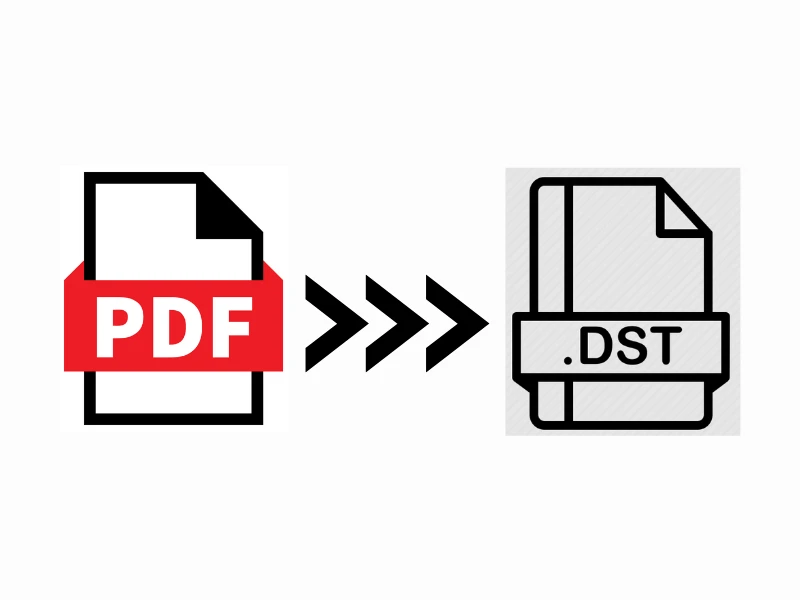

Converting a PDF to a DST file involves more than just transferring file formats. PDFs often contain vector graphics or image data that need to be interpreted and converted into stitch commands for embroidery machines. A DST file is a specialized embroidery format that encodes stitch placements, color changes, and thread trims, enabling your machine to execute the design perfectly.
The conversion requires digitizing software and, more importantly, an understanding of how embroidery works. When a PDF is converted to DST, elements such as shapes, colors, and gradients need to be manually fine-tuned for stitch efficiency. For instance, a simple circle in a PDF may require different stitching techniques like satin or fill stitches, depending on its size and use.
Here’s a detailed process on how to convert a PDF to a DST file. Follow these steps for professional results:
Begin by ensuring your PDF is of high quality and contains only the elements you want to digitize. If the PDF includes unnecessary elements, use graphic editing software like Adobe Illustrator to clean it up. Remove backgrounds or overlapping designs that could complicate the digitization process.

Open professional digitizing software likeWilcom, Hatch, or Brother PE-Design. These software allows you to import vector data or raster images from your PDF file. Import the PDF and check that all design elements are correctly displayed.
If the PDF contains vector data, use the software’s tracing tools to convert those vectors into embroidery objects. For raster images, you may need to manually digitize the design by creating outlines and filling them with appropriate stitch types. Adjust the stitch density, underlay, and thread direction for optimal embroidery.
Assign stitch types based on the design elements. For example:
Satin Stitches: Use for borders and small text.
Fill Stitches: Good for larger areas like backgrounds.
Running Stitches: Perfect for fine details and outlines.
Also, match thread colors to your design, ensuring consistency with your intended output.
Run simulations within the software to identify potential issues such as thread overlaps or excessive trims. Adjust the design to minimize these issues, ensuring a smooth embroidery process.
Once you’re satisfied with the digitized design, export the file in DST format. Check the exported file by loading it onto an embroidery machine for a test run.
When done correctly, a perfect conversion ensures that your embroidery design looks professional and reduces production mistakes. The right conversion process saves time, reduces waste, and enhances the durability of embroidered products.
Converting a PDF to DST with precision has numerous advantages:
Enhanced design accuracy.
Optimized stitching efficiency.
Minimized thread breaks.
Superior output quality.
Reduced production time and cost.
Successful conversion depends on leveraging advanced tools and techniques. Here are the key features to focus on during the process:
High-Quality PDF Input: Ensure clean and clear design elements.
Professional Digitizing Software: Use tools like Wilcom or Hatch for precision.
Stitch Optimization: Adjust density and underlay for perfect embroidery.
Color Consistency: Choose thread colors carefully.
Simulation Tools: Preview designs to avoid errors.
Several online tools claim to convert PDF to DST for free. While these can be useful for basic designs, they often lack the precision required for complex embroidery patterns. Here’s how you can use these tools effectively:
Find a Reliable Online Tool: Use trusted platforms or free-to-use digitizing software.
Upload the PDF: Ensure your file meets the tool’s requirements.
Adjust Settings: Configure basic stitch settings, such as density and thread colors.
Download the DST File: Test the output on an embroidery machine to check quality.
Nick William has been immersed in the world of embroidery digitizing for over 20 years, earning 25 industry awards throughout his career. As a 3rd generation embroidery expert, Nick’s journey started in his family’s workshop, where he learned the art of digitizing before the rise of modern software. He has worked with leading commercial embroidery businesses and has shared his expertise with over 75,000 home and professional embroiderers. As an author at True Digitizing, Nick is passionate about teaching others how to create beautiful, precise designs through easy-to-follow tutorials and expert advice.
Categories

How To Create A Vector File: Step-by-Step Guide
15-04-2025

What Is A Vector File? Everything You Need To Know
14-04-2025

Best Janome Embroidery Machines You Need to Check Out in 2025
11-04-2025

Custom Embroidery Digitized Designs For Hoodie Lovers
10-04-2025

Best Embroidery Patches For Your Clothes
10-04-2025

Professional Online Photo Digitizing Services Provided by True Digitizing
09-04-2025

Best Babylock Embroidery Machines For You
09-04-2025

Barudan Embroidery Machines: From Beginners to Professionals
04-04-2025

Custom Sweatshirt Embroidery Digitized Designs By True Digitizing
03-04-2025

Why Brother Embroidery Machines are the Best Choice for Embroiderers?
27-03-2025